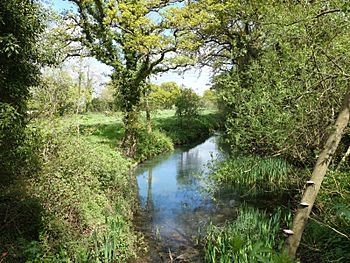Twyford Brook facts for kids
Quick facts for kids Twyford Brook |
|
|---|---|

Twyford Brook, looking upstream from Callin's Bridge
|
|
| Country | England |
| Counties | Berkshire |
| Towns | Twyford |
| Physical characteristics | |
| Main source | White Waltham 51°28′14″N 0°46′20″W / 51.47056°N 0.77222°W |
| River mouth | River Loddon Twyford 51°28′40″N 0°52′15″W / 51.47778°N 0.87083°W |
The Twyford Brook is a small river in Berkshire, England. It flows through countryside east of Twyford. This brook is a branch of the River Loddon. Long ago, it was part of a bigger river system. This system drained the area where the town of Bracknell is now.
But there was a problem with flooding. So, a new channel was dug to help the water flow. This new channel goes to the River Thames at Bray. It is now called The Cut. The old channel became known as Twyford Brook.
Contents
Discover the Twyford Brook
Where the Brook Begins
The Twyford Brook starts near the M4 motorway embankment. This is close to Pondwood Fisheries. In the past, The Cut used to flow along what is now Twyford Brook. But a low-lying area called Ruscombe Common often flooded. It was even known as Ruscombe Lake. This was because water couldn't easily reach the River Loddon.
To fix this, a new channel was built around 1820. This channel, "The Cut," took water directly to the River Thames. This helped drain Ruscombe Lake. The area where the brook starts is now called Snake Water. It is part of Pondwood Fisheries.
In the early 1990s, the owner of Pondwood Fisheries made changes. They widened the stream to create a series of lakes. They also built small dams called weirs. These changes helped control floodwater from the motorway. They also made the fishery even better.
Ancient Moats and Old Farms
West of the fishery, the brook flows under Smewins Road. Nearby is Smewins Farm. Here you can find Smewins Cottage, which is a very old building. It probably dates back to Tudor times. This cottage sits inside a large moat.
A moat is a deep, wide ditch, usually filled with water. The moat here is about 16 metres (52 feet) wide. It is also about 5 metres (16 feet) deep. This site is very important because moats are rare in Berkshire.
The Brook's Winding Path
The Twyford Brook generally flows west. It twists and turns across the land. Smaller drains sometimes join the brook. Before it reaches Callin's Bridge, another drain adds water from Beenham's Heath.
Further along, the brook goes under Crockford's Bridge. Then it turns east to reach Sill Bridge. Sill Bridge is an old humpback bridge from the early 1700s. It has three round arches and is a protected historic building.
The brook then makes a big turn north. It passes under three tracks, including Mire Lane. It flows around the northern edge of an area called Ruscombe Lake. This is the place that used to flood a lot. People used to fish there before it was drained around 1820.
As the brook makes a horseshoe bend, it passes Stanlake Park. This is a large country house built in the 1500s. It has been changed over the years. The stable building next to it is also very old.
West of Stanlake Park, the brook goes under the B3018 road. Then it curves around modern houses in Twyford. It also passes under the A321 Hurst Road. The brook then turns north, flowing next to the River Loddon. It goes under the Great Western main line railway. The railway line to Henley-on-Thames crosses it twice.
Near the end, the brook flows through two underground tunnels called culverts. This allowed houses to be built over it. Finally, the Twyford Brook flows into the River Loddon. This happens near where the old Twyford flour mill used to be.
The Story of Twyford Mill
There have been mills in Twyford since at least 1365. A silk mill was built in 1810. But new laws made it hard for the mill to compete. So, it was sold and became a flour mill. The mill building was very big. It stretched over both Twyford Brook and the River Loddon.
In 1891, a fire destroyed the wooden mill building. But a new one was built. Later, in 1927, a group of farmers bought the mill. They used it to grind animal feed. The mill used water wheels and diesel engines for power. In the 1960s, it switched to electric motors.
Another fire destroyed the mill in 1976. A new, much larger mill was finished in 1979. Part of Twyford Brook was put into an underground tunnel. This allowed the new buildings to be built on land that used to be marshy. The mill closed in the 1990s. Now, houses stand where the mill once was.
Keeping the Water Clean
The Environment Agency checks the water quality of rivers in England. They give each river an overall "ecological status." This status can be high, good, moderate, poor, or bad. They look at things like insects, plants, and fish in the water. They also check for chemicals. Chemical status is either "good" or "fail."
In 2019, the Twyford Brook's water quality was:
| Section | Ecological Status | Chemical Status | Overall Status | Length | Catchment |
|---|---|---|---|---|---|
| Twyford Brook | Bad | Fail | Bad | 6.8 miles (10.9 km) | 15.92 square miles (41.2 km2) |
The water quality of Twyford Brook has changed over time. In 2013, it was "Poor." In 2015 and 2016, it was "Bad." The chemical status was "Fail" in 2013 and 2014. It was "Good" in 2015 and 2016.
The reasons why the water quality is not good include:
- Sewage being released into the river.
- Run-off water from the M4 motorway.
- Fertilizers from farms washing into the river.

